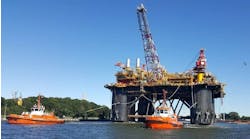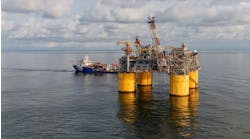Amerada Hess moves the Okume complex into production
Amerada Hess Corp. is stepping slightly off of the beaten path with its development plans for the Okume complex project (formerly northern block G) in the Rio Muni basin offshore Equatorial Guinea. According to John Simon, vice president of West Africa developments for Hess, development plans for the block include two mini TLPs and the first tender assisted drilling to be implemented offshore West Africa.
The Okume complex is a collection of discoveries, including Okume, Oveng, Ebano, and Elon, in the northern part of Hess’ block G license. Hess operates the block with 85% interest, a share that the company acquired through its acquisition of Triton in 2001. Hess’ partners are Energy Africa, now part of Tullow Oil of the UK, with 15% interest, and Equatorial Guinea’s state-operated GEPetrol with 5% carried interest.
The westernmost part of the Okume complex lies in 1,500-2,000 ft of water, while the easternmost portion is in 200 ft.
“The deeper water-depth fields are going to be developed using two mini TLPs, one in 900 ft of water and the other in 1,650 ft,” says Simon.
The development plan incorporates almost solely dry tree solutions. “We don’t anticipate any more than a few subsea wells will be necessary for this development,” says Simon.
“We expect the pay zones to be spread out over a fairly large gross interval, potentially with two or three completion intervals per well. That configuration of wellbore is likely to require future intervention. And interventions would almost certainly be much more expensive if we developed the field using subsea infrastructure.”
The mini TLPs will be the deepwater drilling centers. “We are comfortable that we can drill the high-angle wells necessary from a couple of drill centers to reach the take points in the reservoirs we want to tap,” says Simon.
The TLPs will have front-end processing equipment with three-phase separation. Oil and gas will travel from each TLP via independent flowlines a maximum distance of 14 km to a fixed platform central processing facility (CPF) in the shallow-water Elon area. Treatment systems aboard the TLPs will “polish” the water before discharging it overboard.
Production from the TLPs will combine with that from the Elon-area satellite platforms to feed the CPF, which will have 60,000 b/d of oil and 100,000 b/d water processing capacity. The CPF will feed the Elon satellites and TLPs with injection water and gas lift. The CPF will have 125,000 b/d water injection and 40 MMcf/d of compression capacity. Most of the compression will support gas lift, although gas injection in Elon is also planned, says Simon.
In aggregate, the reservoirs of the Okume complex have a relatively low in situ gas-to-oil ratio. Initially, the fields will produce surplus gas; later, however, recovery of gas injected early in the project life cycle will be needed to satisfy fuel requirements, Simon explains.
“Forecasts indicate that gas injection combined with the amount we’ll use to power our facilities will cut down considerably on surplus gas that would otherwise have to be flared,” says Simon. Hess’ goal is to eventually eliminate flaring.
Employing a tender rig
The Okume complex project will also employ a tender-assist drilling (TAD) rig. Using a TAD unit in conjunction with a TLP is fairly novel. According to Simon, there has been only one other operation of this kind in the industry, undertaken by Unocal on the West Seno project in the Makassar Strait offshore Indonesia.
This solution is more cost and operationally effective than using a self-contained platform rig, says Simon. “A TAD rig can be moved between our two TLPs fairly readily, as most such units are self erecting and self dismantling. Further, the TAD rig’s capabilities are more suited to undertaking the extended-reach drilling we have planned.” The TAD rig will mobilize first onto the Oveng TLP, then to the Okume/Ebano TLP to continue field development.
Hess contracted with Atwood Oceanics to provide theSeahawkTAD rig for the project. Though the schedule does not require the TAD unit to be in place at Oveng until summer 2006, the award was made well in advance. “TAD rigs typically work such long programs, you have to be thinking well down the road,” says Simon.
In October 2004, Hess signed an engineering, procurement, and construction contract with Modec for the two TLPs. According to Simon, this contract covers everything necessary to carry out engineering and design, project management, fabrication, and topsides integration for both TLPs. The contract requires quayside delivery of two fully integrated and pre-commissioned TLPs. A heavy lift transport vessel will convey the platforms to Equatorial Guinea, where others will install them, says Simon. Both units are expected to be in place and operational by May 2006.
“Installation will be undertaken over two campaigns, both by Heerema,” Simon explains. The first, in early 2006, comprises installation of the three Elon-area satellites, the CPF jacket, and the two TLPs. Then in the fall of 2006, Heerema will install the CPF and Elon satellite No. 3 topsides. The CPF and Satellite No. 3 topsides require more time for equipment procurement and topsides integration than the spring 2006 campaign components, says Simon.
“Installing the other Elon-area satellites and the TLPs in early 2006 allows us to embark on our TLP and Elon drilling campaigns early enough to establish meaningful production capacity in advance of CPF installation and first oil,” he says.
By summer 2006, Hess expects to begin drilling on the Oveng TLP and from the second of the three satellites. The company expects first oil to move through the CPF by the end of 2006. “That is our primary objective,” says Simon. A secondary objective is to get the TLPs in place and the Elon satellite No. 2 installed so drilling can begin in the summer of 2006.
According to Simon, in addition to the TLPs and installation contracts, Hess will let 70-75 contracts covering structure fabrication and topsides integration (for the Elon-area platforms) and topsides equipment. Beyond those, another five or six contracts will cover materials for pipelines and risers and their installation, says Simon.
Gulf Island Fabrication Inc., of Houma, Louisiana, won the contract to fabricate all of the Elon-area platform jackets and piles and to integrate the deck and topsides for satellites No. 1 and No. 2. Kiewit Offshore Services won the contract to fabricate the CPF and satellite No. 3 decks and to integrate the topsides for both. Hess is considering proposals for a number of topsides equipment packages and pipeline materials and installation; awards are imminent.
Working the plan
Hess plans to drill 50 wells for the Okume complex, about half of which the company will drill in shallow water from the Elon satellites. A jackup will drill these wells, according to Simon. The plan is for Hess to drill and complete all of the wells by 2009, he says.
The company believes production levels will attain facility capacity fairly early in 2007 and that a plateau production level of 60,000 b/d of oil will be sustained for several years. Hess wants to manage production levels at this plateau to optimize reserve recovery in keeping with water flood response.
In addition to the Okume complex development wells, Hess announced last November that the G-19 exploration well drilled just north of the project area encountered 113 ft of net oil pay. Preliminary plans encompass tying this discovery back to the Oveng TLP using a subsea system.
Hess plans to transport processed Okume complex oil via a 24-km pipeline to the existingSendje Ceiba FPSO, which now supports production from Hess’ Ceiba field. The company will make provisions at the FPSO for segregating or commingling the Okume complex and Ceiba crudes. An existing catenary anchor leg mooring system connected to the FPSO will be used for export offloading.
“At our current forecast for the Ceiba field, we expect both fields to continue to produce at economic rates for 15-20 years after Okume complex first oil. Leveraging the existing FPSO and offloading system will improve opex for both,” says Simon.






